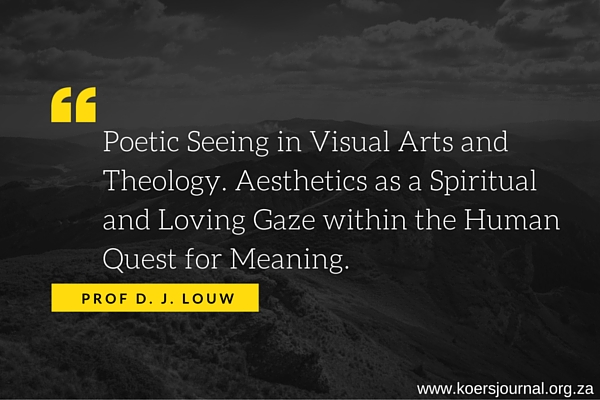Abstract
A human being is essentially homo aestheticus and not in the first place homo faber. In the light of this basic assumption, it is argued that, due to poetic seeing, interconnectedness between art[1], spirituality and the human quest for meaning exists. It is virtually impossible to define art. However, in one way or another, art is connected to imagination, inspiration and creativity. Art probes into the realm of the unseen, thus the value of iconic seeing in visual arts. By means of art, objects are moved into imagination and connected to the ‘idea’ beyond the vision of phenomenological observation. Serious art probes into the dimension of the unseen; it makes the invisible, visible. Art deals inter alia with ‘signals of transcendence’ (Peter Berger)[2] and opens up new avenues for religious thinking and spiritual experiences. Serious art can thus contribute to the healing dimension of spiritual wholeness. Art can even assist theology in the reframing of existing God-images. In this regard, the notions of a Compassionate God and God as Covenantal Partner for Life, become appropriate alternatives for the imperialistic pantokrator-images (omni-categories) of theism.
Poëtiese skoue in visuele kunste en teologie. Estetika as ‘n spirituele en liefdevolle kyk binne die raamwerk van die mens se soeke na sin
Die mens is wesenlik homo aestheticus en nie in die eerste plek homo faber nie. In die lig van die estetiese funksie van ‘n poëtiese skoue kan ‘n netwerkverband tussen kuns, spiritualiteit en die mens se soeke na sin voorveronderstel word. Dit is basies onmoontlik om kuns finaal te definieer. Tog het kuns op een of ander manier te doen met ‘ver-beeld-ing’, inspirasie en kreatiwiteit. Kuns dring die sfeer van die onsienlike binne en ‘maak’ op ‘n skeppende wyse die onsienlike in objekte en visuele waarneming, sigbaar; dit werk heuristies en kreatief-ontdekkend; dit penetreer die sogenaamde ‘idee’ agter dit wat mens in die fenomenologie van waarneming ‘sien’. Kuns is in ‘n sekere sin ikonies en staan in verband met transendensie. Kuns breek brute werklikheid oop en is ‘n soort van venster vir sinvolle spirituele ervaringe en religieuse denke. Ernstige kuns kan beskou word as ‘n vorm van heling op die vlak van ‘spirituele gesondheid’ (wholeness). Die basiese hipotese is dat die visuele kunste teologie kan help om bestaande, geykte vorme van teologisering, te transformeer. So byvoorbeeld kan die imperialistiese pantokrator-idee van‘n ‘onveranderlike, teïstiese God’ (omni-kategorie) deur middel van religieuse estetika verskuif na die sensitiewe ‘Mee-lydende God’ (patos-kategorie): God nie as kousaliteitsbeginsel nie maar as Lewende Verbondspartner.
[1] There are different levels and dimensions of art. The article focuses on the visual arts, although the principles of aesthetics are applicable to all forms of arts.
[2] Peter Berger (1992:121) in A Far Glory: The Quest for Faith in an Age of Credulity. “In openness to the signals of transcendence the true proportions of our experience are rediscovered. This is the comic relief of redemption; it makes it possible for us to laugh and to play with a new fullness.” Signals of transcendence create spiritual spaces for processes of hoping when life seems to be merely the tragedy of a cul de sac.
Copyright information
- Ownership of copyright in terms of the Work remains with the authors.
- The authors retain the non-exclusive right to do anything they wish with the Work, provided attribution is given to the place and detail of original publication, as set out in the official citation of the Work published in the journal. The retained right specifically includes the right to post the Work on the authors’ or their institutions’ websites or institutional repositories.
Publication and user license
- The authors grant the title owner and the publisher an irrevocable license and first right and perpetual subsequent right to (a) publish, reproduce, distribute, display and store the Work in any form/medium, (b) to translate the Work into other languages, create adaptations, summaries or extracts of the Work or other derivative works based on the Work and exercise all of the rights set forth in (a) above in such translations, adaptations, summaries, extracts and derivative works, (c) to license others to do any or all of the above, and (d) to register the Digital Object Identifier (DOI) for the Definitive Work.
- The authors acknowledge and accept the user licence under which the Work will be published as set out in https://creativecommons.org/licenses/by/4.0/ (Creative Commons Attribution License South Africa)
- The undersigned warrant that they have the authority to license these publication rights and that no portion of the copyright to the Work has been assigned or licensed previously to any other party.
Disclaimer: The publisher, editors and title owner accept no responsibility for any statement made or opinion expressed by any other person in this Work. Consequently, they will not be liable for any loss or damage sustained by any reader as a result of his or her action upon any statement or opinion in this Work.
In cases where a manuscript is NOT accepted for publication by the editorial board, the portions of this agreement regarding the publishing licensing shall be null and void and the authors will be free to submit this manuscript to any other publication for first publication.
Our copyright policies are author-friendly and protect the rights of our authors and publishing partners.


_3.png)